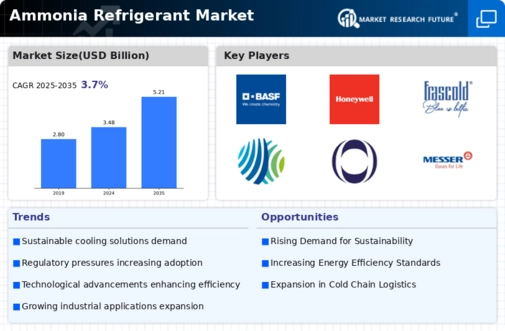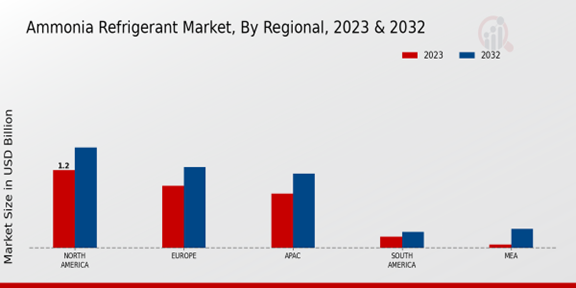Market Growth Projections
The Global Ammonia Refrigerant Market Industry is poised for substantial growth, with projections indicating a market value of 3.48 USD Billion in 2024 and an anticipated increase to 5.21 USD Billion by 2035. This growth trajectory suggests a compound annual growth rate of 3.73% from 2025 to 2035. Factors contributing to this expansion include rising demand for energy-efficient refrigeration solutions, regulatory support for natural refrigerants, and technological advancements in refrigeration systems. As industries increasingly prioritize sustainability and efficiency, ammonia refrigerants are likely to play a pivotal role in shaping the future of refrigeration technology.
Expansion of Cold Chain Logistics
The expansion of cold chain logistics significantly influences the Global Ammonia Refrigerant Market Industry. As global trade increases, the need for efficient cold storage and transportation solutions becomes paramount. Ammonia refrigerants are favored in cold chain applications due to their efficiency and cost-effectiveness. The growth of e-commerce and the food delivery sector further drives this demand, as businesses seek reliable refrigeration solutions to maintain product quality. This trend is expected to contribute to the market's growth trajectory, with projections indicating a rise to 3.48 USD Billion in 2024. The increasing investment in cold chain infrastructure globally underscores the importance of ammonia in meeting these logistical challenges.
Regulatory Support for Natural Refrigerants
The Global Ammonia Refrigerant Market Industry benefits significantly from increasing regulatory support for natural refrigerants. Governments worldwide are implementing stringent regulations to phase out high-GWP refrigerants, thereby promoting the use of environmentally friendly alternatives like ammonia. This regulatory landscape encourages manufacturers to invest in ammonia-based systems, aligning with global sustainability goals. For instance, the European Union's F-Gas Regulation aims to reduce the use of fluorinated gases, creating a favorable environment for ammonia adoption. As a result, the market is expected to grow steadily, with projections indicating a rise to 5.21 USD Billion by 2035, driven by this supportive regulatory framework.
Growing Demand for Energy-Efficient Solutions
The Global Ammonia Refrigerant Market Industry is experiencing a notable surge in demand for energy-efficient refrigeration solutions. As industries strive to reduce operational costs and enhance sustainability, ammonia refrigerants, known for their superior thermodynamic properties, are increasingly favored. This trend is particularly evident in sectors such as food processing and cold storage, where energy efficiency is paramount. The market is projected to reach 3.48 USD Billion in 2024, reflecting a growing recognition of ammonia's benefits. Furthermore, as regulations tighten around greenhouse gas emissions, ammonia's lower global warming potential positions it as a viable alternative, further driving its adoption across various applications.
Rising Awareness of Environmental Sustainability
The Global Ammonia Refrigerant Market Industry is witnessing a shift in consumer preferences towards environmentally sustainable practices. As awareness of climate change and environmental degradation grows, businesses are increasingly seeking refrigerants with lower environmental impact. Ammonia, being a natural refrigerant with zero ozone depletion potential and low global warming potential, aligns well with these sustainability goals. This shift is particularly pronounced in sectors like food and beverage, where companies are adopting ammonia systems to enhance their green credentials. The increasing demand for sustainable refrigeration solutions is expected to propel the market forward, contributing to its projected growth to 5.21 USD Billion by 2035.
Technological Advancements in Refrigeration Systems
Technological advancements play a crucial role in the Global Ammonia Refrigerant Market Industry, enhancing the efficiency and safety of ammonia-based refrigeration systems. Innovations such as advanced control systems, improved heat exchangers, and enhanced safety protocols are making ammonia systems more attractive to end-users. These advancements not only improve energy efficiency but also address safety concerns associated with ammonia's toxicity. As industries increasingly adopt these technologies, the market is likely to see a compound annual growth rate of 3.73% from 2025 to 2035. The integration of smart technologies further supports this trend, enabling real-time monitoring and optimization of refrigeration processes.











